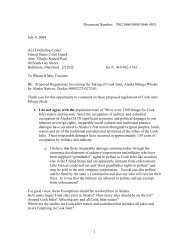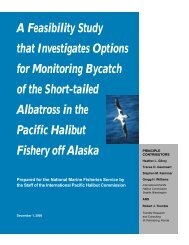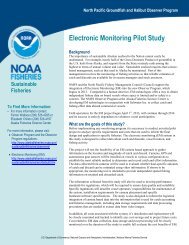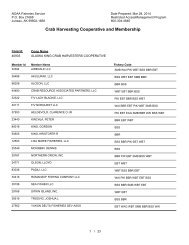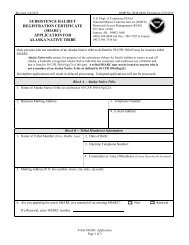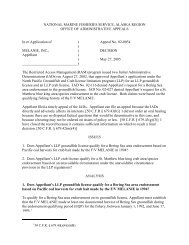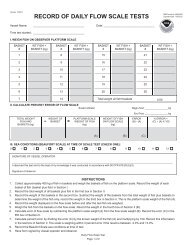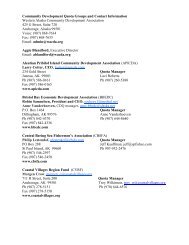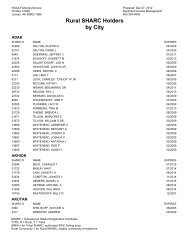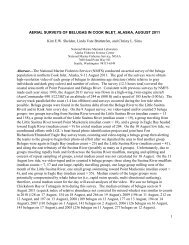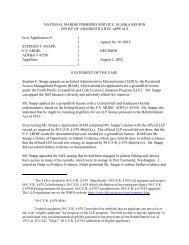Revised Report - National Marine Fisheries Service Alaska Region ...
Revised Report - National Marine Fisheries Service Alaska Region ...
Revised Report - National Marine Fisheries Service Alaska Region ...
You also want an ePaper? Increase the reach of your titles
YUMPU automatically turns print PDFs into web optimized ePapers that Google loves.
identification characteristics for short-tailed, Laysan (P. immutabilis), and black-footed (P.nigripes) albatrosses.The total weight of halibut represented in the seabird data queries was obtained by addingup documented landing weights. The seabird data from the interviewed vessels were matched tothe IPHC log database. The seabird data and the logbook data are in different files, and anycorrections (such as for dealer codes or landing dates) to the log file did not occur in the seabirdfile. Therefore, useable seabird data were reduced by mismatches in the data. The total numberof hooks hauled was calculated for each landing interview that matched a fishing log, by dividinggroundline length of a skate by hook spacing and multiplying it by skates hauled. All seabirdbycatch rates are reported per million hooks interviewed.Of the nearly 67 million pounds of Pacific halibut caught off of British Columbia and<strong>Alaska</strong> in 1998, IPHC port samplers interviewed captains of vessels that represent about 69% ofthe landings (Table 16), and matched interviews to logs for about 52% of the total poundslanded. For the 71 million pounds landed in 1999, interviews represented about 65% of thelandings and matched interviews to log books for about 51% of the landings. In general,proportions of pounds landed and interviews matched to logbooks were higher in BritishColumbia than in <strong>Alaska</strong>. IPHC port samplers conducted 4,000 to 5,000 vessel interviews peryear for 1998 and 1999, and matched 70-90% of the interviews with logbooks (Table 16).Short-tailed Albatross sightings. <strong>Report</strong>ed numbers of short-tailed albatross depends inpart on the number of birds and in part on the number of fishers over time to observe them.Ability to identify the birds and the level of honesty in reporting them could greatly influence thereported distribution of short-tailed albatross. The total number of hooks represented by theinterviews during 1998 and 1999 were similar, around 20 million hooks, but the number of shorttailedalbatross sightings dropped from 138 to 110.For both 1998 and 1999, the halibut fishing effort (as represented by the number of hookshauled for the interviews) followed a similar pattern (Fig. 3). Number of hooks hauled increasedrapidly from March to April to May and June, fell back slightly in July, August, and September,and then dropped rapidly in October. In both years, the greatest number of reported sightingsoccurred in June. In 1998, the number of reported sightings remained at relatively high levels forMay through August, while June dominated the sightings in 1999.The greatest number of reported sightings both years occurred inArea 3A (Fig. 4.) However, the number of hooks hauled dropped nearly50% from 1998 to 1999 even as the reported sightings remained atsimilar levels. The number of short-tailed albatross reported in Area 2Btripled from 1998 to 1999, while the number of hooks hauled increasedabout 50%. Sightings in Area 3B for 1999 dropped to one-third of the1998 level even though the number of hooks hauled dropped only about25%.Seabird avoidance devices. NMFS regulations for <strong>Alaska</strong>nwaters allow a number of seabird avoidance measures. The devicestypically used in <strong>Alaska</strong> and British Columbia include the followingtype categories:• “Buoy” refers to a buoy towed from a line behind the vessel.Fishers usually call this device a bird bag. The erratic motionof the buoy in the wake disturbs the seabirds attempting tofeed on the surface.IPHC photo18



